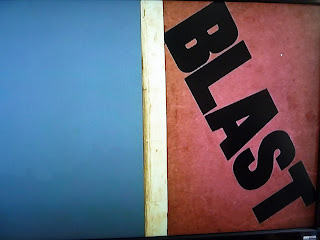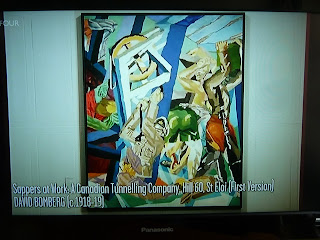
I am not quite certain
why I decided to find out more about the artist David Bomberg maybe I
was just a bit intrigued by one of his paintings or his life which
was different and eventful,
Or maybe I am annoyed that he shot his
toe off and escaped the war where many died.
Studying at the Slade
School of Art Bomberg (1890-1957) along with several other artists of note he
was part of the establishment from an early age even though he was from a poor background, he was destined to be noticed.
The end of World War
One, and a generation would try to overcome the scarring by trying to
build a new world.
David Bomberg would fight in that war and his
splintered life would never be the same.
He unlike some of his
fellow Slade pupils, would go largely un-noticed until his death.
He
was born in Birmingham but he was moved to St Marks Street London
along with his 11 siblings to a Jewish quarter.
His father Abraham
was a gambler who got annoyed at the slightest thing.
Bomberg was always
drawing and he become an apprentice lithographer.
He paid Walter
Sickert for lessons and he sat for John Singer Sargent the society
artist.
He then had stepped
into another world and Sargent helped him to aim for fame and
fortune. The Impressionists of the Continent was dismantling
tradition and in 1910 Roger Fry's Impressionist exhibition was
followed by another which featured Braque and Picasso.
Henry Tonks
became one of his tutors.
Bomberg was funded by the Jewish Education Aid
Society after an initial rejection his education began in 1911, at a new dawn of art. Modernity had arrived.
Tonks
who would say “I shall resign if this talk of cubism doesn't cease,
its killing me”.

Tonks was a stickler he had also tutored Paul Nash
who he had also criticised.
Christopher Nevinson and Stanley Spenser
would study while Tonk's was teaching.
In 1912 'Island of Joy'
became abstract in form, a move away from his past influence.
'Vision of Ezekiel' of 1912 the year of his mothers death paid homage
to his Jewish roots.
This piece of modernism grabbed hold of the
revolution and he went geometric and avant-garde. His work was
jarring and aggressive and he disturbed the other students.
He was
ousted at 23 years old.
'In the Hold'. You would not know
this was a set of workers in the hold of a ship without being told.
A
vibrant kaleidoscope of colours violently reacting with his
surroundings its an explosion of chaos. No wonder he was thought a
misfit.

War broke out and the
likes of Wyndham Lewis would BLAST in a manifesto for the avant
garde. It was meant to be a clarion call to the nations Vorticist
tendencies. Blomberg would not joint the club he was a maverick of
one. These visionaries of desire would strip detail away and throw it
all up in the chaos of experimentation. Bomberg's expo in the Chenil
Gallery saw him proclaiming his ow manifesto.
I reject everything in
painting that is not pure form” he said.

He titled one painting 'Ju
Jitsu'. One work was hung in the street “The Mud-bath” inspired
by Brick lane baths it was framed with bunting, but this was an all
singing all dancing Union Jack. The three colours of red white and
blur was framed within a beige and unceremoniously split by a central
black column. It must have looked bizarre in the time of 1914 just as
war was declared between Austrian Hungary and Serbia after the
assassination of Franz Ferdinand.
He enlisted in The
Royal Engineers and married Alice and then went to fight at The
Somme. He got a lesson in double quick step to carnage. His snatched
sketches show him studying the conflict but he also wrote poems, that
sum up his thoughts in prose.
War is a leveller to
art, art is stripped back to raw emotion. To those who fought and
those who didn't, but also those that can convey the emotion of
death.

I have not read his war
poetry but it is well documented how he talks about fattened maggots
feeding on the lost. His monochrome sketches done in the boredom
before the bomb, he shot himself in the foot. He was withdrawn from
the front. He escaped the death that many had, but he gained the
title of a coward who would leave his fellows to fight for him.
'Sappers at Work' was
commissioned by the Canadian War Memorials fund, that made up for the
rejection of his poetry by all the publishers. His breakdown seems to
show through the brushstrokes. He uses Caravaggio's Martyrdom of St
Peter as a metaphor to the 'Death of Peter by Crucifixion' and uses
the memorial to show the strife the sappers had in carrying out their
deadly death dig below ground, tunnelling away below they laid their
deathly mines and blew all to kingdom come.

In 1923 he went to
Jerusalem in Palestine where a tenth of the population were Jewish.
He was still traumatised and he painted 'Rooftops' in geometric form.
These quiet pictures gave way to depictions of Zionist pioneer camps.
And just like those world war crater scars the quarrymen build their
new developments in the sunshine. In Bomberg's mind.
He was shocked by the
Armenian Genocide and he painted the inside of the church that he was
smuggled into.
He paints shapes in
quick succession and when the earthquake struck chaos ensued, the
painting he was doing in a house was shattered moments after he left.
These pictures were
never accepted by the art establishment.
His work is housed in
the Borough Road Gallery and it houses Sarah Rose's collection.
In 1928 back in London
he met Lillian Holt again and they wed. He went to Spain to follow
the footsteps of El Greco. His work becomes fast and huddled in the
way he paint landscape in contrast to his Palestine pictures. Does he
finally leave his shell shock behind. In Ronda children were born and
so was a new style where the past and the present was
indistinguishable. He paints a bridge over and over again, maybe a
metaphor. He was not to know the deaths that would come from civil
war on that bridge, people would be tossed over to their death.
He returned to London.
And his self portraits continue.
His double headed portrait of 1937
seems to echo in Francis Bacon. He has two faces are his own
reflective past showing his awkwardness and his unsettled thoughts.
He would not paint much longer, and London would be under siege.
'Evening in the City of London' is an energetic and quickly
charcoaled study from the top of St Brides across from St Paul
Cathedral the symbol of the defiance of the blitz. He would not give
in.
Bomberg started a art
class after the war where he taught two nights a week. His Borough
Group were fed his philosophy for the spirit in the man. Miles
Richmond would be part of this group but it fell apart soon after its
formation in 1947.

Holocaust survivors
would daub their emotions in structured chaos of the inner self. The
thoughts of crucifixion of Bomberg as the Messiah. Gustav Metzger who
arrived as a Kinder transport refugee would make 'Auto-Destructive
Art' a film of 1965 using his declaration of an alternative to
painting by spraying acid on to canvas.
In 1965 a set up.
These burning acid canvas would give way to images of St Paul's.
Metzger recently said about Bomberg who taught him “he was poetic
and prophetic if nothing he had charisma”.
Bomberg was sacked from
his teaching position in 1953 and went to teach in Spain. It never
worked out. He always wanted to paint with an economy of means. While
the Vorticists held retrospectives his health faltered. Distance does
not exist he said as he closed his eyes. He was taken back to London
where he died. The arts council held a survey of his career bringing
together 72 works. His last self portrait is a tragedy of doom laden
rejection. Holding his brushes he did not look in the mirror.
He told his students
that great paintings could change the world.

 Though this piece is not cold painted but has a light patination this mirrors the scaly cold blooded skin of a lizard to perfection.
Though this piece is not cold painted but has a light patination this mirrors the scaly cold blooded skin of a lizard to perfection. There can be n excuse for this barbaric act in the early days of the First World War before new style Naval warfare, and the new U-Boat threat had been understoo.
There can be n excuse for this barbaric act in the early days of the First World War before new style Naval warfare, and the new U-Boat threat had been understoo. In an Auction ending on 9th April, a rare piece of Beatles Folklore will be sold by Heritage Auctions of Texas.
In an Auction ending on 9th April, a rare piece of Beatles Folklore will be sold by Heritage Auctions of Texas.